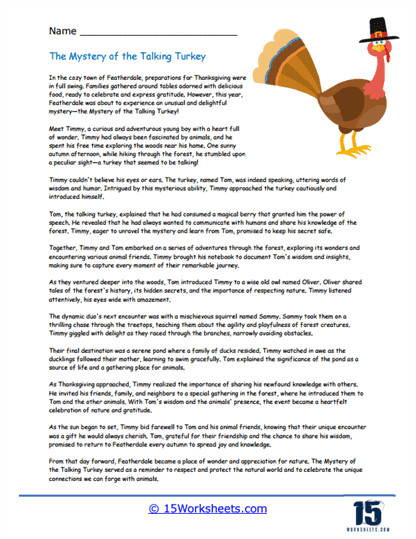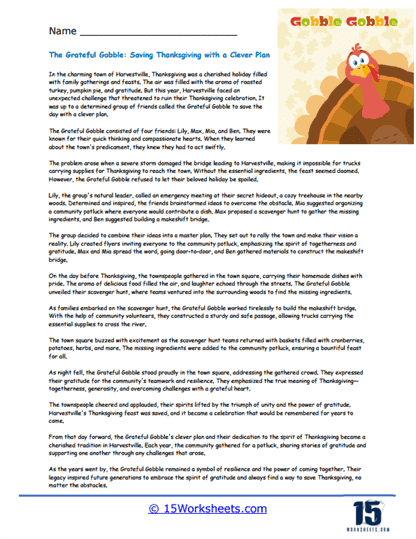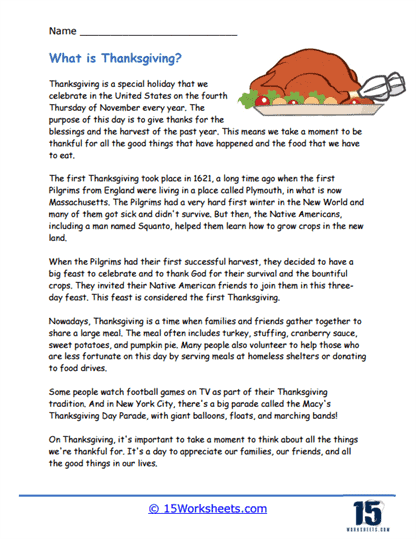Thanksgiving Worksheets
All About These 15 Worksheets
This series of 15 worksheets is an engaging and educational resource designed to celebrate and learn about the history, traditions, and significance of Thanksgiving. These worksheets provide students with an opportunity to deepen their understanding of Thanksgiving, explore its cultural aspects, and foster gratitude and appreciation. By completing a variety of activities, they will develop knowledge, critical thinking skills, creativity, and a sense of community. Through these worksheets, students will:
- Develop their vocabulary by completing a variety of exercises that feature words related to Thanksgiving;
- Demonstrate their knowledge on nouns and verbs through a fun coloring activity on words that are commonly associated with the holiday;
- Share their personal experiences during Thanksgiving by using descriptive language;
- And reflect on the concept of gratitude and the things they are thankful for.
This series provides an immersive and educational resource for students to celebrate and learn about the history, traditions, and significance of Thanksgiving. Through activities encompassing historical context, traditions and customs, and thankful reflections, they will deepen their understanding, foster critical thinking, and develop a sense of gratitude and empathy. Overall, these worksheets promote cultural appreciation, community engagement, and inspire students to celebrate and reflect upon the values of Thanksgiving.
What is Thanksgiving?
Thanksgiving is a national holiday celebrated in the United States and Canada, as well as in some other countries, albeit with different traditions and origins. The holiday is primarily observed as a day of giving thanks for the blessings of the harvest and the preceding year. In the United States, Thanksgiving is celebrated on the fourth Thursday of November, while in Canada, it is celebrated on the second Monday of October.
The origin of Thanksgiving in the United States is often traced back to the 1621 feast shared by the Pilgrims of Plymouth Colony and the Wampanoag Native Americans. The Pilgrims, who were early settlers from England, held a three-day feast to celebrate their successful harvest and to express gratitude for the help they received from the Wampanoag people, who had taught them how to cultivate crops in the New World.
Today, Thanksgiving is an important family-oriented holiday in the United States and Canada. It is typically celebrated with a festive meal that includes traditional dishes such as roast turkey, stuffing, mashed potatoes, cranberry sauce, and pumpkin pie. The holiday is often marked by gatherings of family and friends, parades, and watching American football games.
In addition to the focus on gratitude and spending time with loved ones, Thanksgiving has also become a time for charitable activities, with many people volunteering at food banks, shelters, or community centers to help those in need. The holiday serves as a reminder of the importance of gratitude, community, and togetherness.
How to Incorporate Thanksgiving in Your Class
Incorporating Thanksgiving into your classroom can provide opportunities to teach students about history, culture, and gratitude. Here are some ideas for incorporating Thanksgiving into your class across various subjects:
History and Social Studies
Teach the history of Thanksgiving, including the story of the Pilgrims and the Wampanoag Native Americans, the first Thanksgiving feast, and the establishment of the holiday.
Discuss the traditions and customs of Thanksgiving celebrations in the United States and Canada, and compare them to harvest festivals in other cultures around the world.
Encourage students to research their own family histories and cultural backgrounds, and share their findings with the class.
Language Arts
Assign creative writing projects, such as short stories or poems, with Thanksgiving themes or prompts.
Have students read age-appropriate books, articles, or essays about Thanksgiving, and engage in discussions or writing assignments to analyze and reflect on the texts.
Encourage students to practice their letter-writing skills by writing thank-you notes to someone they are grateful for, such as family members, friends, or school staff.
Art and Crafts
Organize Thanksgiving-themed art projects, such as creating handprint turkeys, designing gratitude trees, or making cornucopias.
Have students design and create Thanksgiving-themed decorations for the classroom or school.
Encourage students to create Thanksgiving-themed cards or crafts to share with family, friends, or members of the community, such as elderly residents in nursing homes.
Math
Incorporate Thanksgiving-themed word problems and math activities that involve cooking, shopping, or planning a Thanksgiving feast.
Teach concepts of measurement and estimation using Thanksgiving-related items, such as calculating the cooking time for a turkey or estimating the number of servings in a recipe.
Science
Explore the science of cooking, including chemical reactions and the properties of different ingredients, through Thanksgiving-themed experiments or demonstrations.
Teach students about agriculture and the science behind growing and harvesting crops, with a focus on the types of foods typically eaten during Thanksgiving.
Social-Emotional Learning
Discuss the importance of gratitude and its benefits on mental and emotional well-being. Encourage students to share what they are thankful for and create a gratitude journal or wall in the classroom.
Engage students in discussions about empathy, understanding, and the importance of helping others. Organize community service projects or charitable activities related to Thanksgiving, such as food drives or volunteering at a local soup kitchen.
By incorporating these ideas into your lesson plans, you can create engaging and educational Thanksgiving-themed activities that foster learning, cultural awareness, and an appreciation for the importance of gratitude and community.


















